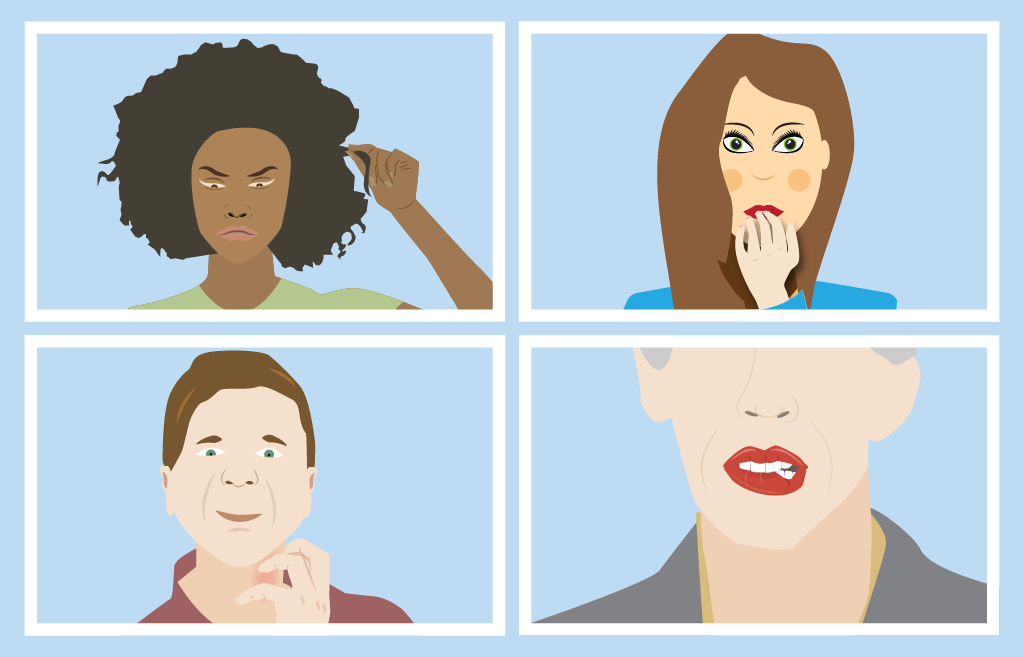
Information about body-focused repetitive behaviors (BFRBs)
BFRBs can be described as excessive self-care behaviors that involve pulling, plucking, or scratching the skin, nails, or hair and result in physical harm.
Differentiation of individual BFRBs
In many cases, different forms of BFRBs occur together. Approximately 50 percent of affected individuals have more than one BFRB. In diagnostic systems, the individual disorders are often scattered. Only trichotillomania (compulsive hair pulling) and dermatillomania (“skin picking”) are currently included in the Diagnostic and Statistical Manual of Mental Disorders (DSM-5; APA, 2013) as separate disorders and are thus officially recognized as mental disorders. Other BFRBs, such as lip-cheek biting, are primarily listed as skin, dental, and oral disorders. They can also be classified under the category “unspecified obsessive-compulsive and related disorders” in the DSM-5.
Prevalence
Different diagnostic criteria are often applied across studies, making reliable estimates of the frequency of this disorder difficult. Mild forms of BFRBs are found in more than 90 percent of respondents; the frequency drops drastically when damage and psychological problems are required as additional criteria (Houghton et al., 2018; Moritz et al., 2024; Solley & Turner, 2018). In a study with 1,481 participants, around 84 percent stated that they currently suffer from a mild form of BFRB (Moritz et al., 2024). Up to 97 percent reported a mild BFRB at least once over the course of their life. In this study, around 24 percent of the participants reported a BFRB that had caused substantial psychological and/or physical harm (Moritz et al., 2024).
Treatment options
BFRBs like trichotillomania can be seen as a perfect storm. Several factors must come together; no single factor is usually sufficient. Often, the characteristics of this disorder have several components:
- Sensory component: for example, dry skin can promote skin picking; thin nails can be a risk factor for nail biting
- Behavioral component: the problem is often automatic and pervasive; once the ritualized behavior is started, it is difficult to stop it
- Psychological component: e.g., stress, low self-esteem, worries about one’s appearance
- For the first component—the sensory urge—there are a number of strategies (e.g., creams for picking, a nail clipper/file in your pocket for nail biting) that we consider helpful.
- For the second component—behavioral aspects—there are a number of treatment options available that have shown to be beneficial in controlled studies. The most evidence has been gathered for habit reversal training. Moreover, decoupling and decoupling in sensu have also been shown to be effective. See more on these techniques under Self-Help Techniques and Videos.
- For the third component—psychological problems—Prof. Moritz and colleagues have developed an app that you can downloaded for free in the App Store. The app is titled COGITO (available for Android and iOS).
Literature
American Psychiatric Association. (2013). Diagnostic and statistical manual of mental disorders (5th ed.). https://doi.org/10.1176/appi.books.9780890425596
Houghton, D. C., Alexander, J. R., Bauer, & C. C. & Woods, D. W. (2018). Body-focused repetitive behaviors: More prevalent than once thought? Psychiatry Research, 270, 389–393. https://doi.org/10.1016/j.psychres.2018.10.002
Moritz, S., Scheunemann, J., Jelinek, L., Penney, D., Schmotz, S., Hoyer, L., Grudzień, D. & Aleksandrowicz, A. (2024). Prevalence of body-focused repetitive behaviors in a diverse population sample – rates across age, gender, race and education. Psychological Medicine, 54(8), 1552–1558. https://doi.org/10.1017/S0033291723003392
Solley, K. & Turner, C. (2018). Prevalence and correlates of clinically significant body-focused repetitive behaviors in a non-clinical sample. Comprehensive Psychiatry, 86, 9–18. https://doi.org/10.1016/j.comppsych.2018.06.014